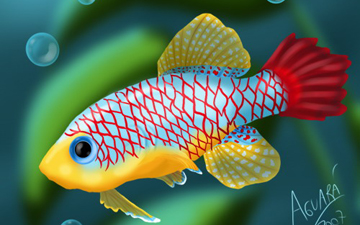Nothobranchius foerschi is a species of fish in the Aplocheilidae family. It is endemic to Tanzania. Its natural habitat is intermittent freshwater marshes.
Nothobranchius (Peters, W., 1868) is a genus of freshwater annual fish from East Africa in the family Nothobranchiidae which was long included in the Aplocheilidae. Many species have very small distributions. There are many species: as of April 2010 there are a total of 60 nominal species, not counting subspecies.[1] They are a typical annual killifish, part of the order Cyprinodontiformes.[2] The vertebrate with the shortest life span is a member of this genus, Nothobranchius furzeri from Mozambique and Zimbabwe lives for between 3 and 6 months. In that time it hatches, matures, breeds and dies.
Killifish feed primarily on aquatic arthropods such as insect (mosquito) larvae, aquatic crustaceans and worms.
Etymology: Greek “nothos”: false, spurious, and “branchia”: gill.
(From Wikipedia, 1 July 2012)
—
Nothobranchius foerschi is a bottom spawner, with a 2-4 month incubation period. This species is easy to maintain in an aquarium (Ref. 27139).
Nothobranchius foerschi can be found in Africa: probably in the upper Ruvu, Mpiji rivers and the lower Rufuji river drainage, eastern Tanzania. It grows to be up to 5cm long.
(From EOL, 1 July 2012)




